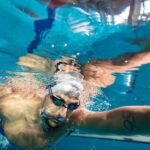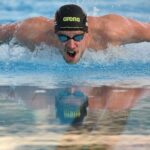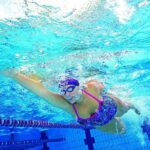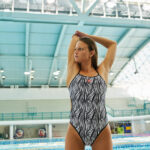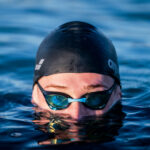How to Improve Your Swimming Starts for Every Stroke
Every competitive swimmer knows the feeling of the intense quiet before the start of a race. In these moments before the start signal, you might feel excited, anxious, calm, or any other number of emotions, but at the end of that silence, when the signal sounds, all that matters is that you execute a good start to kick off your race.
A fast start could provide the time you need to win a race or set a new personal record. We’ll go over the four phases of a swim start: the starting block, the dive, the underwater phase, and the breakout into your stroke. We’ll cover the specific starting techniques used in each of the four swim strokes and provide pointers to aid you in achieving great swimming starts at the beginning of every competitive swimming event.
The Four Phases of Fast Swimming Starts
A swim start consists of the starting block phase, the dive phase, the underwater phase, and the breakout phase. To achieve an overall fast start, you should practice each phase and work on seamlessly linking one phase into the next. A smooth transition between the phases will result in a well-timed and quick race start.
While swim starts vary slightly from one stroke to the next, all the starts have these four stages. We will cover each phase of a swimming start so you can become familiar with the progression of the phases. Plus, we’ll provide specific techniques to use for each of the swim strokes.
On the Starting Block

During this phase, you should focus on developing your starting position, a quick reaction time, and a powerful drive off the block (or wall for backstroke).
A good starting position prepares you for a quick reaction and places your body in the right stance to transfer energy efficiently from your legs into the block or wall. A good starting position greatly aids your overall swimming starts. You should keep a well-balanced position with your legs bent and ready to provide a powerful push off.
Your reaction time is all about focus and preparedness, and it can give you a competitive edge in your race. Perform practice starts before your race. You can also try visualizing starts. The more your mind and body become familiar with taking action right at the signal, the faster your reaction time will be.
Your push off should be explosive and powerful, as this is when you generate the power to propel yourself with distance and speed into your dive. Drive firmly through your feet with even pressure to generate a strong amount of force. You can also try some dryland exercises to increase your leg strength.
Freestyle, Butterfly, and Breaststroke Starting Positions
You will start on top of the block in freestyle, butterfly, and breaststroke. You can choose a track start or a grab start.
For the track start, place one foot forward with your toes hanging over the edge of the block and put your other foot behind you. For a grab start, place your feet side by side with your toes over the edge of the block.
The track start allows for a quicker reaction time to the start signal. It also allows for better balance as you can shift your weight between your front foot and back foot. Try both start styles and see what you prefer.
Regardless of what start position you choose, you’ll want to bend down and grab hold of the front of the block. Bend your knees slightly and shift your center of gravity forward somewhat. If you have chosen the track start, have a little more weight on your front leg but still enough on your back leg that you can drive off of it at the start of the race. Your hips should be slightly above your head, and your head should be in a neutral position.
At the signal, pull yourself forward with your arms and propel yourself off the block using your legs. In the track start, drive off both your front and rear leg to get your momentum going forward. In the grab start, use both legs simultaneously to drive yourself into the dive.
Backstroke Starting Position
In the backstroke starting position, you’ll want to place your feet near the surface of the water against the wall. Grab hold of the handles on the starting block and pull yourself up into the starting position. Your glutes should be very near the surface of the water. Your head should not be bent backward but held in a neutral position.
At the signal, push off the block handles with your arms, and as soon as your body has moved slightly away at an angle, drive through your feet. Propel yourself out of the water, throw your head back, and arch your back. You should be almost out of the water at this point and ready for the dive phase.
During the Dive

The dive itself consists of two sections: the aerial phase and the entry into the water. A successful dive will result in a clean entry into the water with minimal splash. This will allow you to carry speed into your underwater phase, keeping the speed up in your swimming start.
Diving Technique for All Four Strokes
During the aerial phase of your dive, you’ll want to prepare your body for a smooth entry into the water. You should be in a streamlined position before your body enters the water. Your hands should be extended in front of your head, one hand atop the other.
Keep your head and neck in a straight, neutral position in between both of your biceps. Extend your arms as far as you can and squeeze your head between them. Keep your feet pointed behind you. This position will reduce drag when you enter the water.
During the entry, your body should glide into the water one section at a time: hands, arms, head, shoulders, and so on, all the way down to your feet. Maintain a streamlined position throughout your entry into the water, so you keep as much energy as possible moving into the underwater phase of your swim.
During the Underwater Phase
The underwater phase differs slightly depending on what stroke you are swimming. It is important to maintain an excellent streamlined position in all the strokes, so you do not create any unnecessary drag throughout your swimming starts.
Underwater Phase for Freestyle, Butterfly, and Backstroke
In freestyle and butterfly, you will perform an underwater dolphin kick. In backstroke, you will also perform an underwater dolphin kick, but you will face the water’s surface instead of the bottom of the pool. Keep your arms extended in front of your head, and imagine lengthening the entire body to keep a good streamlined position. Use your legs to thrust in an undulating up and down motion to drive you through your underwater phase.
Underwater Phase for Breaststroke
In breaststroke, you are allowed one dolphin kick, a pull with the hands, and a breaststroke kick before your head must break the surface of the water. You’ll want to generate as much power as possible during the dolphin kick, hand pull, and breaststroke kick. All the while, you should maintain a body position that allows you to continue to glide forward. Keep your head down and your body tight, contracting your abs and glutes.
The Breakout Into Your Stroke
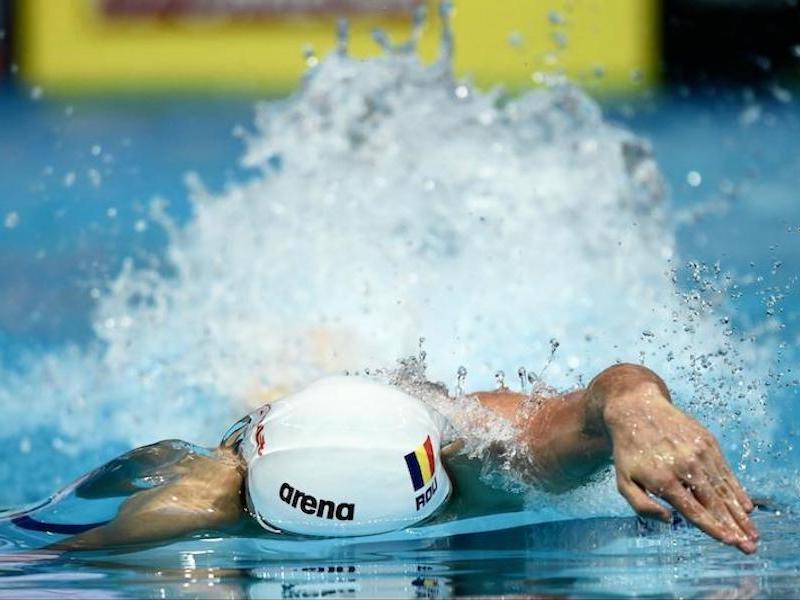
The breakout phase is when you switch over from your underwater phase to your swim stroke. This is when you break the surface of the water. The goal here is to keep all the energy and speed from your underwater phase and allow it to carry over into the swimming part of your race. This part of a start is particularly important for sprinters, where every amount of momentum and speed from the swimming start matters.
You should try for a very explosive movement to break the surface of the water and start your first stroke. It helps to develop your core strength so you can use your abdomen to thrust yourself into your first stroke. Take a powerful first stroke and maintain a strong kick to keep up your speed.
You’ll want to time this out so you do not come too high out of the water or so that you do not try to start swimming before you break the plane of the pool’s surface. A well-timed breakout will help you start swimming with much of the speed you had during your underwater phase.
The Breakout for Freestyle and Backstroke
The breakout for freestyle and backstroke is all about rotation. You want a strong shoulder rotation into your first stroke as you break the surface. Take a very strong initial pull to maintain your speed.
Work on developing a good kick for your breakout. Use a kickboard to strengthen your flutter kick.
The Breakout for Butterfly
The butterfly breakout requires a great butterfly kick paired with a strong pull using your upper-body strength. As you approach the surface of the water, take a powerful dolphin kick toward the surface and use your core to thrust yourself out of the water as you take your first powerful butterfly arm stroke.
The Breakout for Breaststroke
The breakout for breaststroke involves a strong breaststroke pull to bring yourself to the surface of the water. This movement will occur after taking your initial underwater breaststroke kick during your streamline. Use a powerful pull with your arms that brings your head to the surface and then kick and glide into the next stroke cycle.
Time to Train Your Swimming Starts

Time to take your new knowledge about swim starts with you to the pool! The more you practice these techniques, the better your starts will become. Remember to go through each phase of the start, focusing on good form in your starting position, dive, underwater phase, and breakout. Make a smooth transition from one stage to the next, and you’re on your way to having excellent swimming starts.
Visit arena for all the essential gear you need for your swim training. From towels and robes to recovery compression, arena has the equipment you need.
Written by:
Harrison Howarth
Harrison is a freelance writer with a background in competitive aquatic sports. His love for water polo and swim, combined with his passion for writing and education, drives him to continue teaching and inspiring individuals to participate in aquatics.

